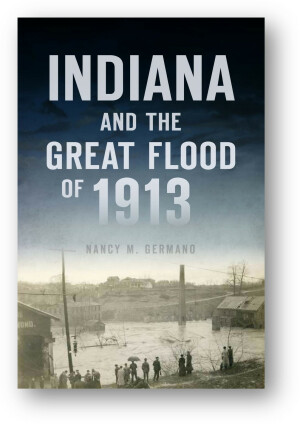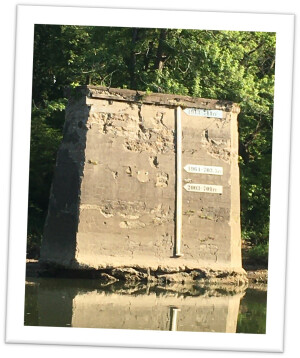About 45 folks came out in the 90-degree weather to hear Dr. Nancy Germano relate the history of Indiana’s great flood of 1913.
 Dr. Germano teaches history from an environmental view at Butler University and is also an author. Environmental history is concerned with the relationship of human activity and natural events. She authored a book about the 1913 flood for several reasons. With the passage of time, events as this can be lost in memory, the period was an important time in Indiana and U.S. history, and there are lessons to be learned going into the future.
Dr. Germano teaches history from an environmental view at Butler University and is also an author. Environmental history is concerned with the relationship of human activity and natural events. She authored a book about the 1913 flood for several reasons. With the passage of time, events as this can be lost in memory, the period was an important time in Indiana and U.S. history, and there are lessons to be learned going into the future.
This weather event started as rain and tornados in the Oklahoma and Nebraska area. It moved east through Illinois into Indiana and on through Ohio to the Atlantic coast. The rain arrived in Indiana on Easter Sunday, March 2013, and covered most of the state. Six inches of water fell over five days all over Indiana. The Indianapolis River gauge washed away, bridges and railroad tracks were washed out, levees were breeched, there was no electric or water service to homes, waste previously in the waterways spread disease, and approximately 7,000 people were homeless in the city.
There had been numerous floods prior to 1913, but this was particularly disastrous due to the increase in population and industrialization. The Indiana capital had been moved from Corydon to take advantage of Indianapolis’ topography and central location.
In 1830, Marion County had a population of 7,192. This increased to 197,227 by 1900. The relatively flat land had been cleared of trees for farming, housing, and industry. Already in 1876, Indianapolis had become a hub of railroads and highways crisscrossing the Midwest. White River, Pogoes Run, the Central Canal, and other waterways all ran through Indianapolis. The clearing of land, population growth, industrialization, and using the waterways for waste disposal all came together for the making of a “perfect storm” for the 1913 flood.
 Few records exist from that time, but approximately 200 deaths, 200,000 homeless, and $20 million in damages (1913 dollars) occurred statewide. President Woodrow Wilson declared a national calamity and appealed for all to hemp the Red Cross and local charities in aiding the displaced and injured people.
Few records exist from that time, but approximately 200 deaths, 200,000 homeless, and $20 million in damages (1913 dollars) occurred statewide. President Woodrow Wilson declared a national calamity and appealed for all to hemp the Red Cross and local charities in aiding the displaced and injured people.
Dr. Germano stated that out of this calamity came a renewed interest in planning and engineering as flooding will continue to be a natural event. Maintaining rivers and wetlands, multi-purpose reservoir projects, wastewater treatment plants and a national flood insurance program for property owners have and will continue to mitigate future flood events.
Submitted by Roger Lindamood (AKA ??)



